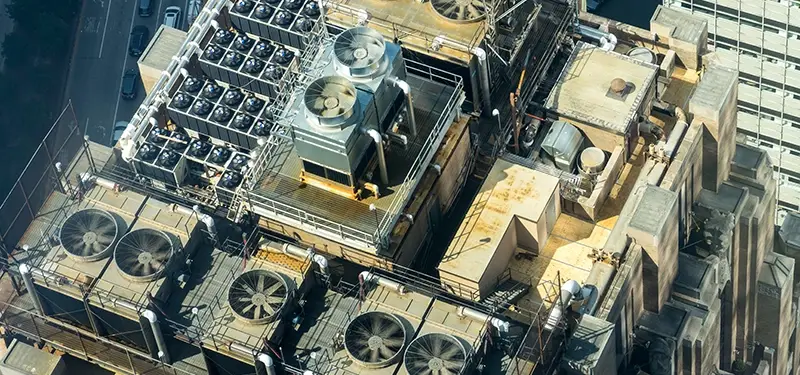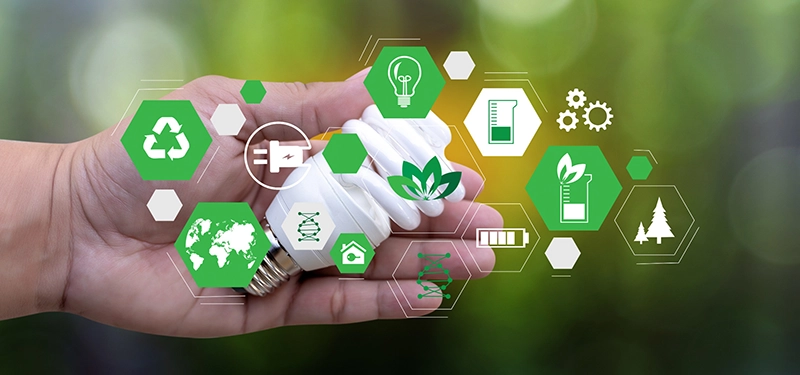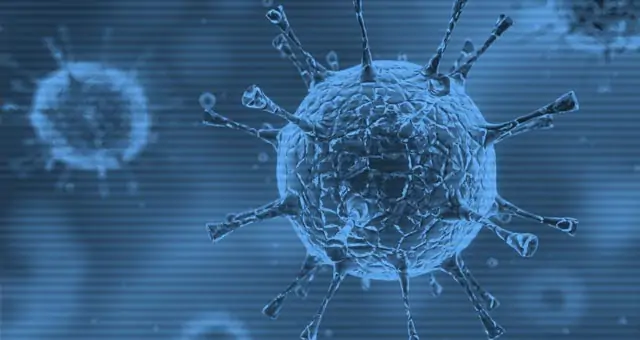Decarbonization and UV Disinfection Technology
August 16, 2023

Concerns about climate change are rising as a result of harmful gas emissions that trap heat in the atmosphere. Without a doubt, we have all heard the term “decarbonization.” It describes the process of offsetting greenhouse gas emissions with greenhouse gas removal. In 2015, 196 countries signed the Paris Agreement in an attempt to limit global warming to less than 2°C above pre-industrial levels. While the goal is still being worked on, much research is being done to develop new technologies that will make it a reality.
Reducing carbon emissions across industries requires the integration of innovative technologies. Germicidal Irradiation (GUV) technology is gaining increasing attention as a promising solution in the HVAC (Heating, Ventilation, and Air Conditioning) sector. Once integrated, UV-C technology can help HVAC systems significantly contribute to decarbonization efforts while improving energy efficiency and air quality.
Keep reading to explore how UV-C technology revolutionizes HVAC systems.
What Is Decarbonization?
It is the process of reducing CO2 emissions that are produced by human activities.
Decarbonization consists of two key steps. The first one is to reduce greenhouse gas emissions that result from the combustion of fossil fuels. One of the methods is to transition to the use of zero-carbon renewable energy sources like wind, solar, hydropower, geothermal, and biomass. Currently, they account for about one-third of global power capacity.
In addition to emission reduction, decarbonization also involves the absorption of carbon from the atmosphere by capturing emissions and enhancing carbon storage in agricultural lands and forests.
To successfully achieve decarbonization, a comprehensive transformation of the entire economy is necessary. This includes rethinking how energy is generated, the production and delivery of goods and services, and the management of land.
The major sectors contributing to carbon dioxide and methane emissions, namely power generation, industry, transport, buildings, agriculture, and land use, must all undergo significant changes.
Why Should We Care?
Addressing climate change and reducing greenhouse gas emissions is important for protecting the environment and building a sustainable future for our children and grandchildren.
The HVAC sector has a big role in decarbonization because it’s one of the largest contributors to global emissions. By adopting sustainable practices and technologies, we can mitigate the environmental impact, conserve natural resources, and reduce our reliance on fossil fuels.

UV-C Technology in HVAC Systems
According to Energy Star, the environmental impact of a building stems from the energy consumed for heating, cooling, and daily operations. By optimizing energy usage, we can create greener buildings that will play a significant role in lessening power consumption and curbing the generation of air pollutants. Let’s take a closer look at how UV-C technology can help.
Enhanced Energy Efficiency
Did you know that HVAC systems often become less efficient because of the buildup of organic matter with biofilm? (Biofilm is a sticky layer of microorganisms that stick to surfaces such as mold and bacteria on cooling coils and other surfaces.) This buildup reduces heat transfer efficiency and obstructs airflow, leading to higher energy consumption.
Integrating UV-C light into HVAC systems can eliminate or reduce this organic matter. Consequently, this integration improves energy efficiency and reduces carbon emissions. Studies have shown that UV-C treatments can result in energy savings of up to 20% or more.
Improved Air Quality
While building greener buildings in the aftermath of the COVID-19 pandemic, we should also remember that indoor air quality is crucial for the health and well-being of occupants. HVAC systems can circulate airborne pathogens, leading to the spread of infections. UV-C technology effectively neutralizes these pathogens by disrupting their DNA structure, reducing the risk of infection, and creating healthier indoor environments. To achieve 90–99% inactivation of most pathogens for air cleaning, it’s important to ensure that the UV-C systems are properly sized with the proper amount of GUV. It’s worth noting that different UV dosages are required for coil disinfection. By reducing the need for chemical disinfectants, UV-C technology promotes greener and more sustainable practices for maintaining air quality. ASHRAE Chapter 62 shows the significant impact of UV-C technology on microbial contamination reduction and air quality improvements.
Reduced Chemical Usage
Traditional HVAC maintenance often relies on chemical cleaners and biocides to control microbial growth. However, these chemicals can have detrimental environmental impacts.
UV-C technology reduces the reliance on chemical disinfectants, minimizes the use of harmful substances, and promotes eco-friendly practices. This reduces the environmental footprint associated with HVAC systems and contributes to overall decarbonization efforts. Research has shown that UV-C technology can effectively reduce microbial contamination without the need for chemical disinfectants.
Future Directions
The aforementioned benefits of UV-C technology only scratch the surface of its potential. Let’s dive deeper into what engineers and scientists are working on together to support our decarbonization efforts.
Advanced UV-C Technologies: Ongoing research and development efforts aim to improve UV-C technology. Examples include the development of more efficient UV-C light sources and the optimization of UV-C dosage. Advancements in UV-C LEDs (Light Emitting Diodes) hold promise for greater energy efficiency, durability, and versatility in various HVAC applications. However, there’s still room to boost this type of technology and make it more cost-effective.
Expansion to Additional HVAC Components: While UV-C technology is commonly used for cooling coils, other applications are well known such as its effectiveness in duct cleaning. The expanded use of UV-C technology will no doubt further enhance energy efficiency, reduce maintenance requirements, and promote sustainable practices.
Aerapy’s In-duct UV Air Purification systems not only neutralize coil surface and airborne mold, viruses, bacteria, and other harmful microorganisms before they circulate throughout your facility, but they also are highly energy-efficient as they use a proprietary sizing method to ensure an optimal outcome. This energy efficiency contributes to overall energy savings and aligns with the goal of reducing carbon emissions in the fight against climate change.
___
At Aerapy, we strive to assist your business in its decarbonization efforts. Our disinfection solutions are energy efficient and chemical-free. All these benefits lead to a more sustainable and low-carbon future. It’s important to achieve decarbonization goals while maintaining high standards of hygiene and safety. Contact us today to learn more about our products and services!
HOW PROTECTED ARE YOU?
Aerapy's commercial-grade UV lights protect your clients, staff, and your business with proven UV disinfection technology. Contact us for more information.
Please send me more information.

Decarbonization and UV Disinfection Technology
August 16, 2023

Concerns about climate change are rising as a result of harmful gas emissions that trap heat in the atmosphere. Without a doubt, we have all heard the term “decarbonization.” It describes the process of offsetting greenhouse gas emissions with greenhouse gas removal. In 2015, 196 countries signed the Paris Agreement in an attempt to limit global warming to less than 2°C above pre-industrial levels. While the goal is still being worked on, much research is being done to develop new technologies that will make it a reality.
Reducing carbon emissions across industries requires the integration of innovative technologies. Germicidal Irradiation (GUV) technology is gaining increasing attention as a promising solution in the HVAC (Heating, Ventilation, and Air Conditioning) sector. Once integrated, UV-C technology can help HVAC systems significantly contribute to decarbonization efforts while improving energy efficiency and air quality.
Keep reading to explore how UV-C technology revolutionizes HVAC systems.
What Is Decarbonization?
It is the process of reducing CO2 emissions that are produced by human activities.
Decarbonization consists of two key steps. The first one is to reduce greenhouse gas emissions that result from the combustion of fossil fuels. One of the methods is to transition to the use of zero-carbon renewable energy sources like wind, solar, hydropower, geothermal, and biomass. Currently, they account for about one-third of global power capacity.
In addition to emission reduction, decarbonization also involves the absorption of carbon from the atmosphere by capturing emissions and enhancing carbon storage in agricultural lands and forests.
To successfully achieve decarbonization, a comprehensive transformation of the entire economy is necessary. This includes rethinking how energy is generated, the production and delivery of goods and services, and the management of land.
The major sectors contributing to carbon dioxide and methane emissions, namely power generation, industry, transport, buildings, agriculture, and land use, must all undergo significant changes.
Why Should We Care?
Addressing climate change and reducing greenhouse gas emissions is important for protecting the environment and building a sustainable future for our children and grandchildren.
The HVAC sector has a big role in decarbonization because it’s one of the largest contributors to global emissions. By adopting sustainable practices and technologies, we can mitigate the environmental impact, conserve natural resources, and reduce our reliance on fossil fuels.

UV-C Technology in HVAC Systems
According to Energy Star, the environmental impact of a building stems from the energy consumed for heating, cooling, and daily operations. By optimizing energy usage, we can create greener buildings that will play a significant role in lessening power consumption and curbing the generation of air pollutants. Let’s take a closer look at how UV-C technology can help.
Enhanced Energy Efficiency
Did you know that HVAC systems often become less efficient because of the buildup of organic matter with biofilm? (Biofilm is a sticky layer of microorganisms that stick to surfaces such as mold and bacteria on cooling coils and other surfaces.) This buildup reduces heat transfer efficiency and obstructs airflow, leading to higher energy consumption.
Integrating UV-C light into HVAC systems can eliminate or reduce this organic matter. Consequently, this integration improves energy efficiency and reduces carbon emissions. Studies have shown that UV-C treatments can result in energy savings of up to 20% or more.
Improved Air Quality
While building greener buildings in the aftermath of the COVID-19 pandemic, we should also remember that indoor air quality is crucial for the health and well-being of occupants. HVAC systems can circulate airborne pathogens, leading to the spread of infections. UV-C technology effectively neutralizes these pathogens by disrupting their DNA structure, reducing the risk of infection, and creating healthier indoor environments. To achieve 90–99% inactivation of most pathogens for air cleaning, it’s important to ensure that the UV-C systems are properly sized with the proper amount of GUV. It’s worth noting that different UV dosages are required for coil disinfection. By reducing the need for chemical disinfectants, UV-C technology promotes greener and more sustainable practices for maintaining air quality. ASHRAE Chapter 62 shows the significant impact of UV-C technology on microbial contamination reduction and air quality improvements.
Reduced Chemical Usage
Traditional HVAC maintenance often relies on chemical cleaners and biocides to control microbial growth. However, these chemicals can have detrimental environmental impacts.
UV-C technology reduces the reliance on chemical disinfectants, minimizes the use of harmful substances, and promotes eco-friendly practices. This reduces the environmental footprint associated with HVAC systems and contributes to overall decarbonization efforts. Research has shown that UV-C technology can effectively reduce microbial contamination without the need for chemical disinfectants.
Future Directions
The aforementioned benefits of UV-C technology only scratch the surface of its potential. Let’s dive deeper into what engineers and scientists are working on together to support our decarbonization efforts.
Advanced UV-C Technologies: Ongoing research and development efforts aim to improve UV-C technology. Examples include the development of more efficient UV-C light sources and the optimization of UV-C dosage. Advancements in UV-C LEDs (Light Emitting Diodes) hold promise for greater energy efficiency, durability, and versatility in various HVAC applications. However, there’s still room to boost this type of technology and make it more cost-effective.
Expansion to Additional HVAC Components: While UV-C technology is commonly used for cooling coils, other applications are well known such as its effectiveness in duct cleaning. The expanded use of UV-C technology will no doubt further enhance energy efficiency, reduce maintenance requirements, and promote sustainable practices.
Aerapy’s In-duct UV Air Purification systems not only neutralize coil surface and airborne mold, viruses, bacteria, and other harmful microorganisms before they circulate throughout your facility, but they also are highly energy-efficient as they use a proprietary sizing method to ensure an optimal outcome. This energy efficiency contributes to overall energy savings and aligns with the goal of reducing carbon emissions in the fight against climate change.
___
At Aerapy, we strive to assist your business in its decarbonization efforts. Our disinfection solutions are energy efficient and chemical-free. All these benefits lead to a more sustainable and low-carbon future. It’s important to achieve decarbonization goals while maintaining high standards of hygiene and safety. Contact us today to learn more about our products and services!
HOW PROTECTED ARE YOU?
Aerapy's commercial-grade UV lights protect your clients, staff, and your business with proven UV disinfection technology. Contact us for more information.
Please send me more information.

